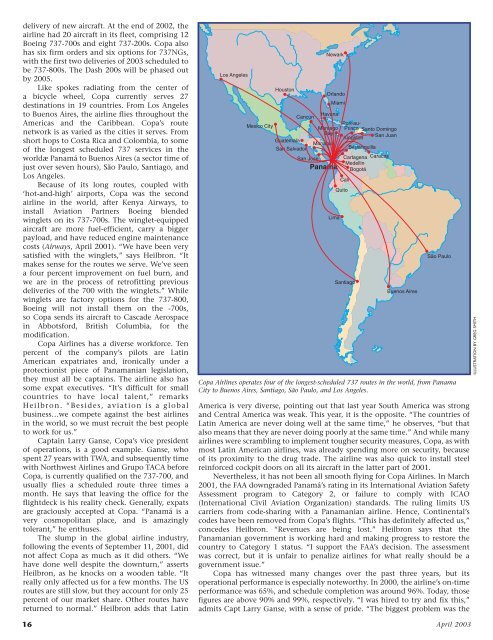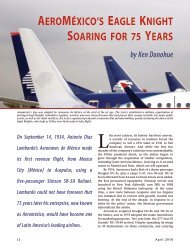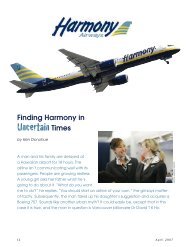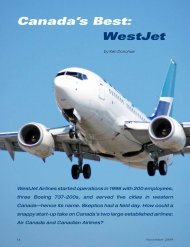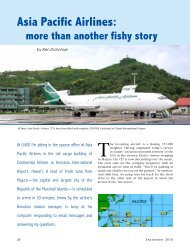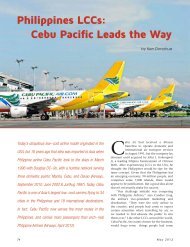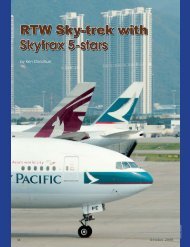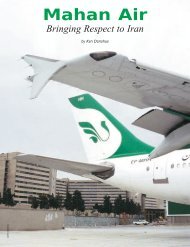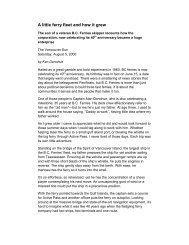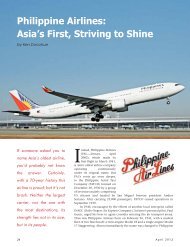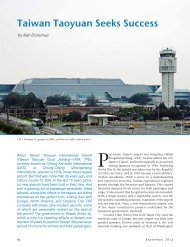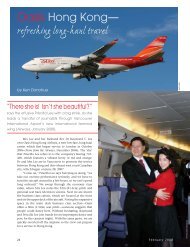Copa Airlines - Ken Donohue
Copa Airlines - Ken Donohue
Copa Airlines - Ken Donohue
You also want an ePaper? Increase the reach of your titles
YUMPU automatically turns print PDFs into web optimized ePapers that Google loves.
delivery of new aircraft. At the end of 2002, the<br />
airline had 20 aircraft in its fleet, comprising 12<br />
Boeing 737-700s and eight 737-200s. <strong>Copa</strong> also<br />
has six firm orders and six options for 737NGs,<br />
with the first two deliveries of 2003 scheduled to<br />
be 737-800s. The Dash 200s will be phased out<br />
by 2005.<br />
Like spokes radiating from the center of<br />
a bicycle wheel, <strong>Copa</strong> currently serves 27<br />
destinations in 19 countries. From Los Angeles<br />
to Buenos Aires, the airline flies throughout the<br />
Americas and the Caribbean. <strong>Copa</strong>’s route<br />
network is as varied as the cities it serves. From<br />
short hops to Costa Rica and Colombia, to some<br />
of the longest scheduled 737 services in the<br />
worldæ Panamá to Buenos Aires (a sector time of<br />
just over seven hours), São Paulo, Santiago, and<br />
Los Angeles.<br />
Because of its long routes, coupled with<br />
‘hot-and-high’ airports, <strong>Copa</strong> was the second<br />
airline in the world, after <strong>Ken</strong>ya Airways, to<br />
install Aviation Partners Boeing blended<br />
winglets on its 737-700s. The winglet-equipped<br />
aircraft are more fuel-efficient, carry a bigger<br />
payload, and have reduced engine maintenance<br />
costs (Airways, April 2001). “We have been very<br />
satisfied with the winglets,” says Heilbron. “It<br />
makes sense for the routes we serve. We’ve seen<br />
a four percent improvement on fuel burn, and<br />
we are in the process of retrofitting previous<br />
deliveries of the 700 with the winglets.” While<br />
winglets are factory options for the 737-800,<br />
Boeing will not install them on the -700s,<br />
so <strong>Copa</strong> sends its aircraft to Cascade Aerospace<br />
in Abbotsford, British Columbia, for the<br />
modification.<br />
<strong>Copa</strong> <strong>Airlines</strong> has a diverse workforce. Ten<br />
percent of the company’s pilots are Latin<br />
American expatriates and, ironically under a<br />
protectionist piece of Panamanian legislation,<br />
they must all be captains. The airline also has<br />
some expat executives. “It’s difficult for small<br />
countries to have local talent,” remarks<br />
Heilbron. “Besides, aviation is a global<br />
business…we compete against the best airlines<br />
in the world, so we must recruit the best people<br />
to work for us.”<br />
Captain Larry Ganse, <strong>Copa</strong>’s vice president<br />
of operations, is a good example. Ganse, who<br />
spent 27 years with TWA, and subsequently time<br />
with Northwest <strong>Airlines</strong> and Grupo TACA before<br />
<strong>Copa</strong>, is currently qualified on the 737-700, and<br />
usually flies a scheduled route three times a<br />
month. He says that leaving the office for the<br />
flightdeck is his reality check. Generally, expats<br />
are graciously accepted at <strong>Copa</strong>. “Panamá is a<br />
very cosmopolitan place, and is amazingly<br />
tolerant,” he enthuses.<br />
The slump in the global airline industry,<br />
following the events of September 11, 2001, did<br />
not affect <strong>Copa</strong> as much as it did others. “We<br />
have done well despite the downturn,” asserts<br />
Heilbron, as he knocks on a wooden table. “It<br />
really only affected us for a few months. The US<br />
routes are still slow, but they account for only 25<br />
percent of our market share. Other routes have<br />
returned to normal.” Heilbron adds that Latin<br />
Los Angeles<br />
Mexico City<br />
Houston<br />
Cancún<br />
Newark<br />
Orlando<br />
Miami<br />
Havana<br />
Montego<br />
Bay<br />
Guatemala<br />
Managua<br />
San Salvador<br />
San Jose<br />
Panama<br />
Lima<br />
Port-au-<br />
Prince Santo Domingo<br />
Kingston<br />
San Juan<br />
Barranquilla<br />
Cartagena Caracas<br />
Medellin<br />
Bogotá<br />
Cali<br />
Santiago<br />
Buenos Aires<br />
São Paulo<br />
<strong>Copa</strong> <strong>Airlines</strong> operates four of the longest-scheduled 737 routes in the world, from Panama<br />
City to Buenos Aires, Santiago, São Paulo, and Los Angeles.<br />
America is very diverse, pointing out that last year South America was strong<br />
and Central America was weak. This year, it is the opposite. “The countries of<br />
Latin America are never doing well at the same time,” he observes, “but that<br />
also means that they are never doing poorly at the same time.” And while many<br />
airlines were scrambling to implement tougher security measures, <strong>Copa</strong>, as with<br />
most Latin American airlines, was already spending more on security, because<br />
of its proximity to the drug trade. The airline was also quick to install steel<br />
reinforced cockpit doors on all its aircraft in the latter part of 2001.<br />
Nevertheless, it has not been all smooth flying for <strong>Copa</strong> <strong>Airlines</strong>. In March<br />
2001, the FAA downgraded Panamá’s rating in its International Aviation Safety<br />
Assessment program to Category 2, or failure to comply with ICAO<br />
(International Civil Aviation Organization) standards. The ruling limits US<br />
carriers from code-sharing with a Panamanian airline. Hence, Continental’s<br />
codes have been removed from <strong>Copa</strong>’s flights. “This has definitely affected us,”<br />
concedes Heilbron. “Revenues are being lost.” Heilbron says that the<br />
Panamanian government is working hard and making progress to restore the<br />
country to Category 1 status. “I support the FAA’s decision. The assessment<br />
was correct, but it is unfair to penalize airlines for what really should be a<br />
government issue.”<br />
<strong>Copa</strong> has witnessed many changes over the past three years, but its<br />
operational performance is especially noteworthy. In 2000, the airline’s on-time<br />
performance was 65%, and schedule completion was around 96%. Today, those<br />
figures are above 90% and 99%, respectively. “I was hired to try and fix this,”<br />
admits Capt Larry Ganse, with a sense of pride. “The biggest problem was the<br />
Quito<br />
ILLUSTRATION BY GREG SMITH<br />
16 April 2003


